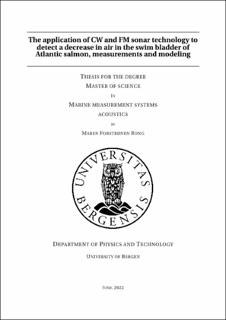The application of CW and FM sonar technology to detect a decrease in air in the swim bladder of Atlantic salmon, measurements and modeling
Master thesis
Permanent lenke
https://hdl.handle.net/11250/3000819Utgivelsesdato
2022-06-01Metadata
Vis full innførselSamlinger
- Master theses [168]
Sammendrag
Salmon lice and poor surface conditions are challenging for salmon aquaculture. A new innovative preventative solution is to submerge the cages below the sea surface to avoid the surface-dwelling infestation of lice larvae. However, the physostomous salmon require daily surface access, or the swim bladder will deflate. The ensues negative buoyancy leads to increased swimming speed, and over a prolonged time (2-3 weeks), the appetite and growth rate may be reduced, resulting in poor welfare. For 28 days, 500 salmon were placed in a cage submerged to 1 m depth, preventing the salmon from reaching the sea surface and refilling the swim bladder. Beneath the cage, three EK80 scientific wide-band echo sounders with 70, 120, and 200 kHz split-beam transducers were deployed to study the acoustic backscatter over time. From the backscattered signals, parameters such as the target strength (TS), volume backscattering strength (S_V), the frequency response of both TS and S_V, and the swimming speed could be calculated. These parameters are studied to determine the first to indicate an insufficient air level based on signal type and frequency. The results show an increase in swimming speed and a decrease in both TS and S_V values. From the measured daily TS values from both FM and CW signals, the decrease appeared to begin from day 6 of submergence. As the air in the bladder diminished, the ratio between the values from the three echo sounders increased, which was evident from TS and S_V measurements, and the frequency responses. The swimming speed acquired from the acoustical recordings decreased from day 5, but the speeds were unexpectedly high. These findings may be used to develop automatic alarms that detect low swim bladder inflations or poor welfare and provide new fundamental knowledge about backscattering from salmon.
